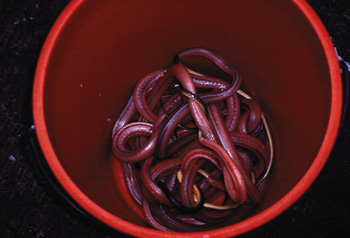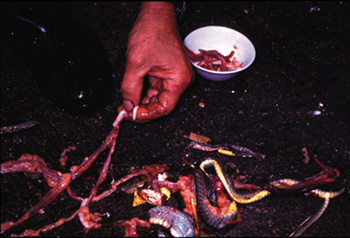 Left: Snakes are precious food in the eyes of some Asians.
Left: Snakes are precious food in the eyes of some Asians. Right: Snake’s flesh is torn into pieces within minutes.
Right: Snake’s flesh is torn into pieces within minutes.



Wild cuisine
Some people see wildlife as delicious — and nutritious. . .
By Wylie Yeo


 Left: Snakes are precious food in the eyes of some Asians.
Left: Snakes are precious food in the eyes of some Asians.
 Right: Snake’s flesh is torn into pieces within minutes.
Right: Snake’s flesh is torn into pieces within minutes.
O utside a restaurant on Temple Street, passers-by are witnessing a death.
With his bloody hands, a middle-aged butcher is using a pair of scissors to tear flesh into pieces. Yet, no one interferes. Some of the witnesses are even waiting to eat the meat of the writhing victim.
Mr. Tse Yan Ping, 46, the owner of a snake restaurant called Sher Wong Sin, conducts the slaughter.
The victims are a tangle of snakes, whose flesh and organs are regarded as delicacies and as precious ingredients for traditional Chinese medicine.
The biggest snake that Mr. Tse has ever slaughtered was a 15-foot python. That was in 1978.
“The greatest obstacle for a snake slaughterer is fear. As being bitten by snakes is inevitable, snake slaughterers have to overcome any fear of pain,” said Mr. Tse, who acquired his unusual skill in 1977.
He said that when he is bitten by a snake, he tries to cure the wound with Chinese herbs. Different herbs are for different kinds of poison. He goes to hospital only if the condition is serious.
Said Mr. Tse: “In the old days, all snake restaurants had ceiling fans. By hanging the pythons on these fans, slaughterers cut their heads off. Yet, this bloody scene is never seen now. Under current legislation, pythons cannot be killed for commercial uses.”
Mr. Tse kills more than 100 snakes every day. To kill a snake, he first beats it heavily against the ground until it is partly paralysed. He then cuts its head and peels its skin off. With its guts removed, the snake then becomes a long hollow of flesh. Yet, it is still writhing.
Finally, Mr. Tse strips the flesh from the snake’s backbone. The whole process takes only five minutes. The meat is then passed to the cook.
According to Mr. Tse, the optimal season for snake eating is autumn, preferably between the Mid-Autumn Festival and the Ching Ming Festival. The Chinese believe that during this period, the snakes are entering winter dormancy. Their flesh is therefore more delicious.
However, Mr. Tse pointed out that good quality snakes are available throughout the year. The snake eating season is in fact mostly determined by customer demand.
From autumn to early spring, most snake restaurants organize “snake fare”, serving a type of thick soup made of snakes and called tse gong. Mr. Chan Ghee Keung, owner of Sher Wong Kee, another restaurant in Temple Street, said, “Following a specific recipe, any staff can prepare it. It’s simple.”
With over 30 years’ experience as a cook, he said the quality of meat is a crucial factor for preparing dishes. He chooses only the best snakes, which he said are lively and have shiny scales.
Mr. Chan added that properly served dishes should allow a customer to eat with chopsticks without too much trouble. Said he: “The meat shouldn’t contain any bones. Otherwise, the customer will have to spit out the bones in an act of bad table manners.
“Besides, snakes cut into horizontal segments are difficult to hold tightly with chopsticks,” said Mr. Chan.
Mr. Chan said some customers prefer eating endangered snake species like cobras. However, Mr. Chan revealed that the meat of different species in fact have a similar taste.
Nearly all snakes are now imported from China. According to the Agriculture and Fisheries Department, importing endangered species requires an import licence as well as an export document from Chinese authorities. Each species must have a licence each time, but the number of individual snakes imported is not restricted.
A source requesting anonymity said illegal trafficking in profitable species takes place in spite of the law. As the number of imported snakes is not restricted, the unlicensed snakes are sometimes lifted together with the legal ones by lorries at Man Kam Road check points.
Traditionally, Chinese believe that different parts of snakes have salutary effects on human health. Therefore, many of its organs are sold at high prices.
Mr. Chan said the most valuable part of snakes is the gallbladder. The price of a fresh gallbladder ranges from $10 to $1,000, depending on the size and the species of snake.
In Sher Wong Kee, a “three-snake” gallbladder, which combines the gallbladders of three ordinary snakes, costs $240. Compared with the flesh of a whole snake, which costs only about $50, it is much more expensive.
Said Mr. Chan: “Old Chinese believe that swallowing a gallbladder along with Chinese liquor can alleviate pain in the joints.”
Mr. Kwan Chi Yee, the chairman of Society of Practitioners of Chinese Herbal Medicine, confirmed this traditional belief.
Said Mr. Kwan: “Snake gallbladders can refresh the human body. Together with liquor, which facilitates blood circulation, the nutrients of the gallbladder can be absorbed faster.”
In addition, it is believed that snake blood has the same function as the gallbladder. Said Mr. Tse: “By cutting off the snake’s tail, the patient then suck the blood directly from the snake. Yet the efficacy of this is still unproven.”
Apart from the gallbladder, a snake has another allegedly beneficial organ — the penis.
According to Mr. Tse, snake penises soaked in Chinese herbs and liquor for two or three years can be sold at $200 per bottle.
Mr. Tse said people have the misconception that this liquor can strengthen a man’s sexual prowess. He said it is the herbal medicines, rather than the organ itself, that make the difference.
Snakes are not an ordinary food in the eyes of foreigners. Ms Anna Cox, an exchange student from the United States, thinks eating snakes is odd. She was shocked when she first saw snake-slaughtering on the street.
Apart from snakes, Chinese also like eating such endangered species as the masked palm civet, the so-called fruit fox, and lizards.
The importation of fruit foxes is restricted under the Convention on International Trade and Endangered Species of Wild Fauna and Flora. According to a spokesperson for the Agriculture and Fisheries Department, no living fruit foxes have been imported legally from China since the convention was implemented. On the other hand, their frozen carcasses are brought in as a substitute.
Wild animals are not always delicious. Having been boiled for hours, the flesh of lizards is tasteless. Nevertheless, it is believed that it can cure asthma. The longer the tail of a lizard, the more effective it is in nourishing human lungs, they say. It is useful for patients suffered from serious cough and difficult breathing after exercises.
A woman who requested that her name be withheld said her daughter got asthma two years ago. Yet, by drinking lizard soup every week starting from last year, the girl has almost fully recovered now, and she can stop taking Western medicines. The daughter is now a university student.
But the girl herself has a different theory: She thinks that after entering the university, she has become healthier because of the cleaner air there.


